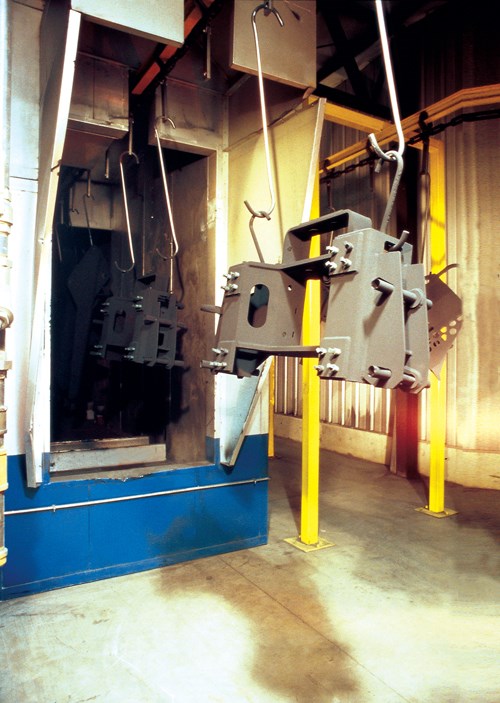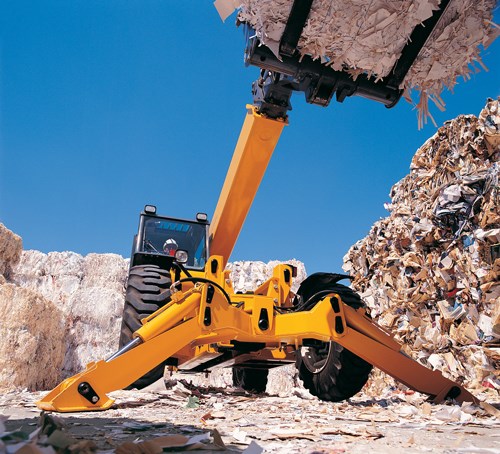Reducing Powder Coating Waste
Coating application is often overlooked as a potential money saver, but recognizing opportunities within this area is crucial to an efficient operation.
Heavy equipment manufacturers and the tier suppliers that support them typically have firm coating specifications in place, so when it comes to choosing the right coating, quality and specification compliance are given. What differentiates the right coating from the almost right coating is its ability to improve the bottom line, reduce overall costs and meet performance requirements, without over-engineering the solution.

Coating application is often overlooked as a potential money saver, but recognizing opportunities within this area is crucial to an efficient operation.

All coatings are not created equal; some can withstand very high temperatures and some are more resistant to UV rays.
The Most Important Factor
Transfer efficiency, the percentage of a coating that adheres to a substrate compared to the amount of material applied to the substrate, is the single most important factor in achieving a cost-efficient coatings process for large- and small-scale finishers. There are many factors that can reduce powder coating transfer efficiency, such as poor part grounding, improper equipment settings, airborne contaminants or simply using too much reclaimed powder without adding the proper ratio of virgin material. Coating efficiency, reflected as a percentage, can drop significantly—in some cases to 50 percent or less—and that is money out the door when excess and unusable powder is discarded.
In liquid coating applications, transfer efficiency and overall finishing quality can be increased through newer technologies such as higher solids coatings. Containing higher volume solids, they offer the advantage of fewer coats, better corrosion resistance and edge retention. An added advantage is reduced VOCs. For plastics and composite substrates such as carbon fiber, primer can actually be injected into the molding, increasing the adherence of the topcoat, while also eliminating an entire step in the process.
Working with a coatings supplier to understand transfer efficiency levels and how they can be raised is to every finisher’s benefit, especially because ideal transfer percentages depend on the substrate and part being coated.
Large or Small, the End Goal is One Size Fits All
Both OEM and tier supplier coating programs should have the same end goal—a quality finish applied properly at the lowest price. Wasting time is just as detrimental as wasting product. A coatings supplier, regardless of its coating prices, should be able to offer its customers a partnership in which overall finishing prices may be reduced by keeping a few procedures in mind, such as:
1. Proper painter/operator training
2. Equipment upgrades
3. Preventive maintenance programs

Working with a coatings supplier to understand transfer efficiency levels and how they can be raised is to every finisher’s benefit.
Finishers that invest in ongoing training programs for their applicators cut costs by increasing knowledge and reducing waste. Coating suppliers work directly with the applicators to educate them about how the overall coating system and application equipment work together to produce a desired end product. Here are a few examples that may seem small on the surface, but can make a huge impact:
Adjust spray gun and pump pressure to proper settings. High pressures waste coatings and can increase gun and pump wear.
Increase the number of parts per linear foot of conveyor whenever possible. This minimizes waste, improves productivity and optimizes conveyor part window capacity without sacrificing quality.
Institute an optimum gun-to-part distance, based on the parts being finished, to minimize waste.
(For manual applications) Spray even and steady strokes to achieve desired film thickness at all times.

Costs should be evaluated at the customer level. OEMs must ask the question: “Am I working with a supplier capable of meeting all of my needs?”
Equipment upgrades and maintenance also play an important role in reaching preferred cure and cost per applied foot.
Essential finishing equipment may be different for every finisher, but spray booths, spray guns and pumps are some of the basic tools in any coatings system. Finishing equipment should be subjected to performance standards and necessary upgrades. Establishing a schedule based on pace of production for standards testing is one way to ensure a high quality end product.
Old, outdated line equipment can impact finished product quality, increasing cost per square foot and even leading to scrap or reworked parts. Regular equipment review and assessment is paramount to running a productive coatings operation. New equipment can pay for itself quickly if transfer efficiency and throughput are increased.
In addition to equipment upgrades, preventative maintenance programs are necessary to keeping coating costs low during the finishing process. Keeping the application area free of dust, dirt and clutter should be a core part of any maintenance program. For powder coating applications, temperatures within the application area should be constant between 65 and 75 F, with humidity between 40 and 60 percent. Higher temperature and humidity levels can cause a decrease in retention of the electrostatic charge.

Increase the number of parts per linear foot of conveyor whenever possible. This minimizes waste, improves productivity and optimizes conveyor part window capacity without sacrificing quality.
An important component of preventive maintenance is equipment care. Spray booth lighting checks will help maintain the necessary visibility for application coverage. Shadow minimization and light from above and the sides should provide adequate illumination. Also, changing spray booth filters on a regular basis increases optimization and decreases downtime.
Coating quality will only be as good as the quality of its environment. Equipment left unkempt can result in days of downtime opposed to hours of downtime for scheduled maintenance. Spray equipment should be routinely tested for consistency and accuracy. For powder coatings, process ovens should be cleaned regularly with the proper treatments, and hangers and fixtures should be cleaned to provide thorough electrical continuity.
Cost-Reducing Program for Large OEMs
Although resources can be limited in today’s marketplace, there are ways for large OEMs to keep production plans in check. One of these methods is establishing a vendor-managed inventory program—an onsite solution for product cycle counts, stock rotation and replenishment that uses agreed-upon minimums to keep overall production costs low.
Product stock levels are not always paid the proper attention. With a vendor-managed inventory program, the responsibility of keeping coatings in-stock is shifted from an OEM purchaser to the coatings supplier. From a purchasing standpoint, the number of transactions can be reduced because products are paid for as they are used, versus being paid for ahead of time. That means more cash flow for the OEM.
By introducing a vendor-managed inventory program, a large OEM can reduce labor costs and decrease production disruptions, ultimately increasing throughput. It’s one less worry in the production process.
Cost-Reducing Program for Tier Suppliers
Costs should be evaluated at the customer level. OEMs must ask the question: “am I working with a supplier capable of meeting all of my needs?”
Bundled liquid and powder offerings, local inventory stock and technical service should not be sold as “value-adds.” They should be expected in a partnership that leads to finishing success. Responsive customer assistance on the production lines should also be a given.
The cost associated with processing a purchase order makes one-stop shopping the ideal solution for OEMs and their suppliers. Implementing a lean purchasing process can result in additional savings. For example, personal protection equipment—such as gloves, safety glasses and pant suits—are necessary for any finishing job. If a coatings supplier can provide these consumables, as well as deliver high quality coatings and training/efficiency programs, it offers customers value far beyond the coatings.
Establishing a True Partnership
Considering the applied product cost and overall performance at the recommended film thickness will allow finishers to see the true price when making product choices, but finishers should consider establishing a true partnership with a coatings manufacturer that adds value beyond product sales.
Proper operator training, equipment upgrades and preventative maintenance programs are all essential to running an efficient coating operation, but a finisher should look to its supplier to investigate potential savings and determine ways to improve and enhance the overall program. Success can then be measured by the improvement of the bottom line and reduction in overall costs – the end goal every heavy equipment manufacturer hopes to achieve for its finishing operations.
Dave Zelch is global industry director for Heavy Equipment and Military, The Sherwin-Williams Company
Related Content
TTX’s Automated Conveyor Carrier System Offers Wireless, Flexible Operation
ACC system designed for reliable, consistent point-to-point movement of everything from small to heavy parts.
Read MoreReduced, Reused and Recycled Powder Coatings Are the Future
They say necessity is the mother of invention, and with millions of pounds of powder coating going into landfills a year, these two companies have found novel approaches to dealing with this waste stream.
Read MoreMasking Solutions Provider CFS Dramatically Expands Capabilities and Capacity
Custom Fabrication & Supplies (CFS) completed a new plant expansion packing 10 times the capacity into twice the space. It dramatically enhances the supplier’s custom capabilities to provide extremely precise and cost-effective masking solutions.
Read MoreProducts Finishing Reveals 2023 Qualifying Top Shops
Each year PF conducts its Top Shops Benchmarking Survey, offering shops a tool to better understand their overall performance in the industry. The program also recognizes shops that meet a set of criteria to qualify as Top Shops.
Read MoreRead Next
Are TGIC-Free Powder Coatings Right For You?
This alternative to TGIC-based polyester powder coatings offers similar performance and enhanced transfer efficiencies.
Read MoreDelivering Increased Benefits to Greenhouse Films
Baystar's Borstar technology is helping customers deliver better, more reliable production methods to greenhouse agriculture.
Read MoreEpisode 45: An Interview with Chandler Mancuso, MacDermid Envio Solutions
Chandler Mancuso, technical director with MacDermid Envio discusses updating your wastewater treatment system and implementing materials recycling solutions to increase efficiencies, control costs and reduce environmental impact.
Read More





















